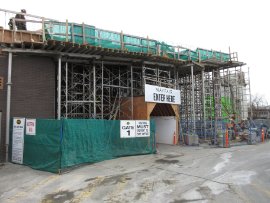New Covered Walkways Guidelines Published

Covered walkways primarily shield pedestrians from the hazards of a construction site, including falling objects and other construction debris, but they can also provide a platform for the staging of construction materials, or for the placement of temporary construction office trailers. Additionally, covered walkways may serve as the base structure for the attachment of signage. As covered walkways have clear life-safety implications, it is important that they are properly engineered and constructed.
“Covered Walkways play a vital role in protecting public safety during construction activities. By clearly outlining expectations for design, review, and coordination, these guidelines help ensure that temporary structures are not only functional but also meet the highest standards of professional practice,” said Kendra Zammit, a Practice Advisor with Engineers and Geoscientists BC.
“We hope these guidelines will support registrants in delivering safe, effective solutions that reflect technical excellence and regulatory compliance.”
These guidelines discuss requirements for covered walkways outlined in the BC Building Code, the Vancouver Building By-law, and the Occupational Health and Safety Regulation. Additionally, the guidelines outline considerations for engineers designing and supervising covered walkways, including, but not limited to:
- minimum dimensions and appropriate railings;
- wind load;
- anchorage;
- soil bearing capacity; and
- impacts on adjacent construction site or adjacent properties.
The Professional Practice Guidelines – Engineering Services for Temporary Structures: Covered Walkways are available on our website.
Photo: Stefan Alexander



